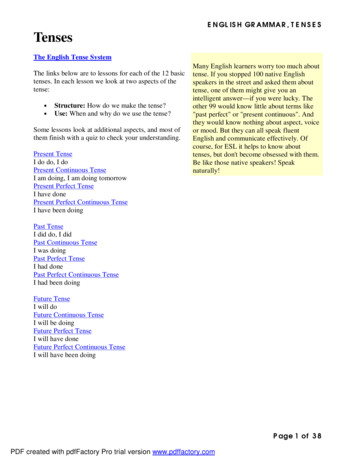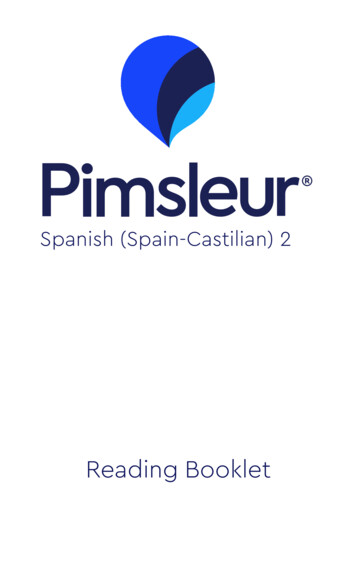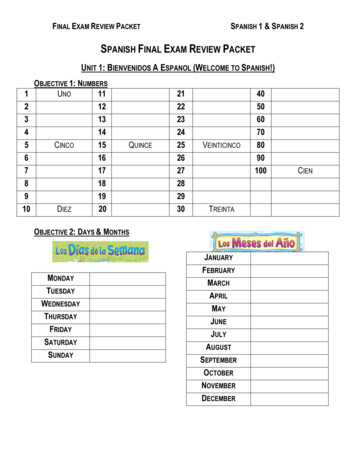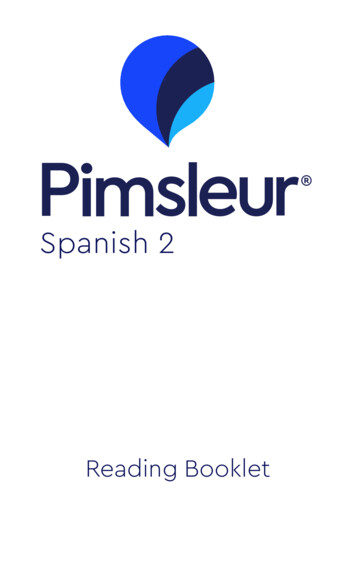
Transcription
PRINTIT!Spanish Conjugation ChartSimple Tenseswww.howtoconjugatespanishverbs.com
This chart presents conjugation for all simpletenses of the Indicativo mood.Each page is set up for print as A4 size with 3 cm overlap so you canput it together and hang it on the wall.To view the chart online in Deep Zoom anishconjugation-chart-simple-tenses/Copyright 2012, 2013How to Conjugate Spanish VerbsAll Rights Reserved
PretéritoImperfectoUsed when describing habitual events in the pastAnd ongoing actions which were happening simultaneously.REGULARIRREGULARThere are only 3irregular verbsIn Pretérito Rhabl abahabl abashabl abacom íacom íascom unfahabl ábamoshabl abaishabl abancom íamoscom íaiscom sveíanWeYou (pl)They/unfamNotice: All endings inthe grey area are thesameNotice: ver has the sameendings. Just add E to the stem.
PretéritoPerfectoUsed to describe an action or event in the past that isand to describe series of events that folously.RREGULARspellinBecause theby a/o/u anthe stem to3bsrfecto the lettersfollowed b the lettersfollowed b letter c whby a/o/uERIRARERHABLARsIYouShe/he/unfamiliar youmosisnWeYou (pl)They/unfamiliar you s/vosotrasellos/ellas/Uds.COMERhabl éhabl astehabl ócom ícom istecom ióhabl amoshabl asteishabl aroncom imoscom isteiscom ieronCQTOCYOTOQNotice: All endings inthe brown area are thesameirregularity
téritofectohe past that is viewed as over and done withevents that follow one another.IRREGULARspelling correction necessaryspelling correction necessaryBecause the pronunciation is different when the letter c, g and z are followedby a/o/u and different when followed by e/i, we need to change the spelling ofthe stem to preserve the pronunciation of the infinitive.Because it would be hard to pronounce the letter Ibetween vowels, we need to change it to the letter y. Thissituation happens in the -ER and -IR groups where thestem ends with the vowel. the letters qu when followed by e/i are pronounced like the letter c whenfollowed by a/o/u the letters gu when followed by e/i are pronounced like the letter g whenfollowed by a/o/u letter c when followed by e/i is pronounced like the letter z, when followedby a/o/uSome verbs change-AR-ER -IRCARGARZARQUGUCTOCARLLEGARStem endswith vowelINCLUIRYÓ S/ELLAS/USTEDESirregularity caused by spelling OS/ELLAS/USTEDESPIDI
The following verbshave irregular stems:ome verbs change last vowel RONonly those 2 verbs are in this steioimosisteisieronimoisteiierothe only difference
PreUsed to describe an action,And to talk about things in general, or to saREGULARg verbsar stems:ARERIReisteoeisteioIyoushe/he/unfamiliar youimosisteisieronimosisteisieronweyou (pl)they/unfamiliar you (pl)the only abl ohabl ashabl acom ocom escom eviv oviv esviv ehabl amoshabl áishabl ancom emoscom éiscom enviv imosviv ísviv enNotice: All endings inthe red area are thesameNotice: the -ER and -IRgroups have commonparts in their endings
Presenteibe an action, state or event in the present momenteneral, or to say that something happens all the time or repeatedlyULARRsIRREGULARCompletely irregularverbs:-AR -ERIREVIVIRESTAR HABER SERIRviv oviv esviv eestoyestásestáhehashasoyeresesvoyvasvaviv imosviv ísviv amosvaisvane: the -ER and -IRps have commonts in their SMENTÍSDOMIENTENDELLOS/ELLAS/USTEDES
Spelling correctionnecessarySpelling correctionnecessaryThose verbs belong to the group which in theinfinitive form contains a diphthong. It means aweak vowel i/u and a strong vowel a/e/o arecombined in a single syllable giving a sound whichbegins as one vowel and moves towards the other.English also has it in words like: cloud, coin.A weak u followed by a strong a/e/oin a single syllable form a diphthong.It means the u would lose a distinctsound in pronunciation and theword formed would not soundsimilar to the infinitive any more.For that reason, to match thepronunciation, we need to addthe letter y between the vowels.In this verb group the weak vowel is stressed inpronunciation, so to preserve it in writing(avoiding the diphthong) we need to add anaccent.-AR -ER �ANEVALÚANINCLUYENMIENTENirregularity caused by spelling correction
rectionstrong a/e/om a diphthong.ose a distinctand thet soundany more.tch theed to addhe vowels.OESEENUsed tThe first person singular is irregularand needs to be memorized.ALLSOME-CER/ -CIR-ER/ -IRCuse G in the s.
FuturoUsed to describe an action or event that will happen in the futureAnd to indicate an intense demand.REGULARIRREGULARThe following verbshave irregular stemsbut regular endings:ARERIRHABLAR sellos/ellas/Uds.hablar éhablar áshablar áhablar emoshablar éishablar tisfarNotice: The irregularverbs use the sameregular endings éásáIyoushe/he/unfamiliar youemoséisánweyou (pl)they/unfamiliar you (pl)
REGULARSTEMREGULARENDING
REGULARSTEMREGULARENDING
YOIRREGULARSTEM IN “YO”I- YREGULARENDINGREGULARSTEMIRREGULAR ENDINGIN ÉL/ELLA/USTEDAND ELLOS/ELLAS/USTEDES
Él/ELLA/USTEDELLOS/ELLAS/USTEDESIRREGULAR STEMIN ÉL/ELLA/USTEDAND ELLOS/ELLAS/USTEDESREGULARENDING
REGULARSTEMREGULARENDING
ARNG/USTEDESMIENTEND
MIENTENDUERMENPIDENESQUÍANEVALÚANirregularity caused by spelling IRREGULAR STEM REGULARIN SINGULAR FORMS ENDINGAND ELLOS/ELLAS/USTEDESINCLUYEN
ENYOIRREGULARSTEM IN “YO”REGULARENDINGREGULARSTEM
REGULARSTEMENDINGIRREGULARSTEMREGULARENDING
Spanish Conjugation Chart Simple Tenses www.howtoconjugatespanishverbs.com. This chart presents conjugation for all simple . irregular verbs In Pretérito Imperfecto aba abas aba ábamos abais aban HABLAR COMER habl habl habl habl habl habl com com com com com com ía










